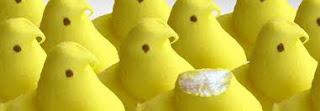
If you celebrate Easter, you've probably already made tentative plans for the holiday, such as whether you'll be attending church (you should), what you intend to do afterwards (toasting the new pope comes to mind), and, most important, what you'll be serving for dinner. Because, let's face it, when it comes to celebrating Easter Sunday, religious observance is only one half of the equation. The other half is all about food. There's the candy, of course: chocolate bunnies, creme-filled eggs, and those godawful Peeps. (Who in God's name actually
likes those things?)

And then there's Easter dinner: ham, asparagus, and that quivering Jell-O mound with whipped cream on top. There are variations, naturally. Some people opt for roast lamb or pork instead of ham. Some prefer to bite the head off a chocolate chick instead of a chocolate bunny. But the basic theme is pretty much the same from household to household.
If you happen to live in North America, that is. That's right. Surprise! There are actually places in the world where people celebrate Easter sans ham and Jell-O and...shudder...Peeps. And I'm here to tell you about some of them. So, let's start off with a gooey little concoction known as the "butter lamb"...

Isn't it cute? And it's made entirely of butter, which also makes it dangerous. But cholesterol concerns aside, the butter lamb is an essential part of Easter dinner in the homes of Polish Catholics, as well as in some Russian and Slovenian households as well. And there's a definite protocol involved when it comes to eating it. According to tradition, the tail has to be consumed first, then the body, and, finally, the head. If you happen to be the one eating the head, you might want to watch out for the peppercorns that represent the eyes. They can be pretty crunchy. And if the thought of sculpting your own butter lamb leaves you feeling a little daunted...don't worry. You can always buy a ready-made one at your local deli and
pretend that you did it yourself. Who's going to rat you out? The Easter Bunny? Speaking of which...

While chocolate bunnies might be an Easter mainstay in most western cultures, in Australia, basket-toting rabbits made of chocolate aren't quite as popular. Seems that real rabbits have wreaked so much havoc on the Australian environment that a little marsupial known as a bilby has become the preferred image when it comes to Easter chocolate. The Foundation for Rabbit-Free Australia first introduced the bilby as an alternative to the traditional Easter bunny in 1991, and the concept has been steadily gaining ground ever since. There are even Easter Bilby books and stories to go with it. None of which makes any difference to real bilbies, who, unlike real rabbits, are on the endangered species list. But if you're not into chocolate bilbies
or rabbits, you can always try your luck with duck...

Baby ducks, that is. Embryos, to be even more precise...and disgusting. But, hey, I don't make these things up, I just blog about them. And the fact is that, in the Philippines, the idea of boiling fertilized duck embryos in their shells and eating them is considered absolutely normal. Not to mention yummy. Known as
balut to those who love it, this macabre little delicacy can be served plain or with seasoning (garlic and vinegar is highly recommended) and is usually accompanied by a beer (I'd need an entire six-pack
and a blindfold). The creepiest part of balut consumption (to me, anyway) is that no balut afficienado worth his or her salt would even think of eating one until the duck embryo was at least 17 days old, at which point the feathers, beak, and claws have started to form, but the bones are still soft, making it easier to chew them. But if the thought of eating duck embryos makes you sad (and not just
sick), you'd probably be better off eating your Easter meal in a country where ducklings (ugly ones anyway) are allowed to turn into swans instead of balut. Yes, I'm talking about Denmark, whose inhabitants celebrate Easter with a traditional
lunch instead of dinner, the most important component of which is...

No, not mermaids. Don't be silly. Mermaids aren't real, and even if they were, they're half-human, which brings up all sorts of ethical issues when it comes to eating them. But the Danes have no such problem eating fish, especially herring, as part of their Easter lunch. Slathered on dark bread and washed down with a good beer, herring is as popular at Easter time in Denmark as it is at Christmas time and on any other major or minor holiday. True, the traditional Danish Easter lunch includes other dishes as well, such as roast lamb and eggs, but herring...pickled,fermented, or otherwise...is the one dish that Danes would miss if it wasn't there. But what else would you expect in a country that is basically an island in the North Sea? For those of us who aren't especially enamored of fish, it's fortunate that the Danes are equally committed to brewing excellent beer.
Well, I could go on, obviously. But sometimes less is more, and in this case, I've decided that it's true. I hope you enjoyed this brief peek at what some other people in the world will be eating on Easter. And I hope you enjoy whatever you choose to include on your menu. (I just hope it's not those damned Peeps.)

Skol!



























